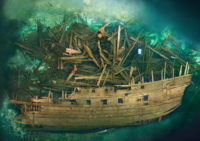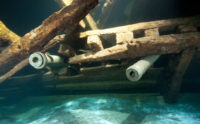 The wreck of the 16th century Swedish warship Mars, flagship of King Eric XIV (r. 1560-1568), son of Gustav Vasa, first of his dynasty and first king of an independent Sweden, has been captured in defiance of visibility conditions at the bottom of the Baltic in a crystalline combination of footage and 3D rendering.
The wreck of the 16th century Swedish warship Mars, flagship of King Eric XIV (r. 1560-1568), son of Gustav Vasa, first of his dynasty and first king of an independent Sweden, has been captured in defiance of visibility conditions at the bottom of the Baltic in a crystalline combination of footage and 3D rendering.
In an ironic twist that isn’t all that ironic given the length of time involved, King Gustav Vasa had begun to build a permanent, state-run Swedish navy (as opposed to the medieval system of drafting merchant vessels for war duties as needed) with ships he bought from the Hanseatic city of Lübeck. After his death in 1560, his son Eric picked up where Dad left off, investing heavily in the development of a navy that could protect his crown, still tenuous given his father’s rebellion. Grasping at straws of legitimacy wherever he could find them, Eric slapped all those numbers after his name, claiming descent from ever so many Erics before him, real or legendary, related or not.
His Danish cousins were not impressed. They considered him a usurper just like his father. One of Eric’s solutions was to ramp up Swedish naval strength to control trade on the Baltic. Big ships were a key part of this plan. In 1561, he engaged master shipwright Holgerd Olsson to build the biggest ship yet. It was Eric’s idea to call it the Mars after the Roman god of war, telegraphing even more clearly his bellicose intent. Mars was completed in the fall of 1563, just in time for the fireworks. Also known as the Makalös (Matchless), the ship was big, the largest ever up until that point on the Baltic. It was said to be longer than Lübeck’s cathedral of St. Peter.
 The Danes didn’t appreciate Eric’s ambitious encroachment on their turf in the lucrative Baltic market and neither did Lübeck. In 1563, the conflict escalated into the Northern Seven Years’ War. It was Sweden against Denmark–Norway, Lübeck and the Polish–Lithuanian union. Sweden’s navy was already intimidating compared to its rivals. It had 38 ships, 16 of them large warships. The Mars was armed with at least 100 guns, perhaps as many as 200, depending on which source you believe. Its heavy artillery enabled it to fight at a distance, eschewing the old-fashioned boarding followed by hand-to-hand combat tactics that had dominated naval warfare for so long.
The Danes didn’t appreciate Eric’s ambitious encroachment on their turf in the lucrative Baltic market and neither did Lübeck. In 1563, the conflict escalated into the Northern Seven Years’ War. It was Sweden against Denmark–Norway, Lübeck and the Polish–Lithuanian union. Sweden’s navy was already intimidating compared to its rivals. It had 38 ships, 16 of them large warships. The Mars was armed with at least 100 guns, perhaps as many as 200, depending on which source you believe. Its heavy artillery enabled it to fight at a distance, eschewing the old-fashioned boarding followed by hand-to-hand combat tactics that had dominated naval warfare for so long.
When the Mars and other Swedish warships went up against the fleets of Denmark, Lübeck and the Polish–Lithuanian union off the coast of the Swedish island of Öland on May 30th, 1564, at first Mars seemed to dominate the field. With those big guns of hers, she disabled the Danish flagship Fortuna and sank the Lübeckian ship Alte Bark. The Danish and Lübeckian commanders realized they would have to board her or face certain defeat. On day two of the engagement, they managed to do just that. The only problem is the Mars was on fire. The enemy crews only had enough time to board her and initiate looting procedures before they were all blown sky high in an explosion so powerful that it shot the ship’s mainmast straight up in the air like a crossbow bolt. The Mars sank quickly, taking many coins, cannons and lives to the cold Baltic seafloor with it.
After decades, centuries even, of fruitless searches, in 2011 the wreck of the Mars was found near Öland 250 feet below the surface of the water. Even though it went down in such a spectacular fashion, it was in excellent condition. Its guts were exposed in the explosion, but the wood has been perfectly preserved by the Baltic’s slow currents, cold water and lack of woodworm.
From its discovery in 2011 through 2015, marine archaeologists have been studying the wreck under very difficult conditions. It’s so deep and cold, visibility is literally zero and it’s not possible to dive in a regular way. They needed a special mix of gases to protect them from the bends, and documenting the wrack in total darkness required specialized scanning equipment.
Over the course of several years, a research team led by Johann Rönnby, professor of maritime archaeology at Sweden’s Södertörn University, has photographed and scanned the 453-year-old wreck Mars, the legendary flagship of Swedish King Erik XIV. […]
The Mars wreck site was discovered in 2011 by Rönnby’s team near the Swedish island of Öland. Initial investigations of the vessel, lying at a depth of 250 feet, indicated that a combination of slow currents and a dark and cold environment helped to facilitate the stunning preservation of the wooden warship.
National Geographic helped fund the research, so keep your eyes peeled for the story to air on its cable channel. Meanwhile, here’s a taste of the breathtaking footage and rendering drawn from a site that requires hand-held Klieg lights to see even a tiny part of it.
Deep Sea Productions filmed the exploration of the wreck for a documentary. Below is a brief introductory video to the production and a surprisingly enjoyable clip of reenactments from the film. I’m not a fan of what I deem to be an overreliance on reenactments in history documentaries because I find them a cheesy shortcut to generate feeble “action scenes” as if the history itself couldn’t possibly keep bums in seats. I have to admit these look not too bad. (Still not good tho.)